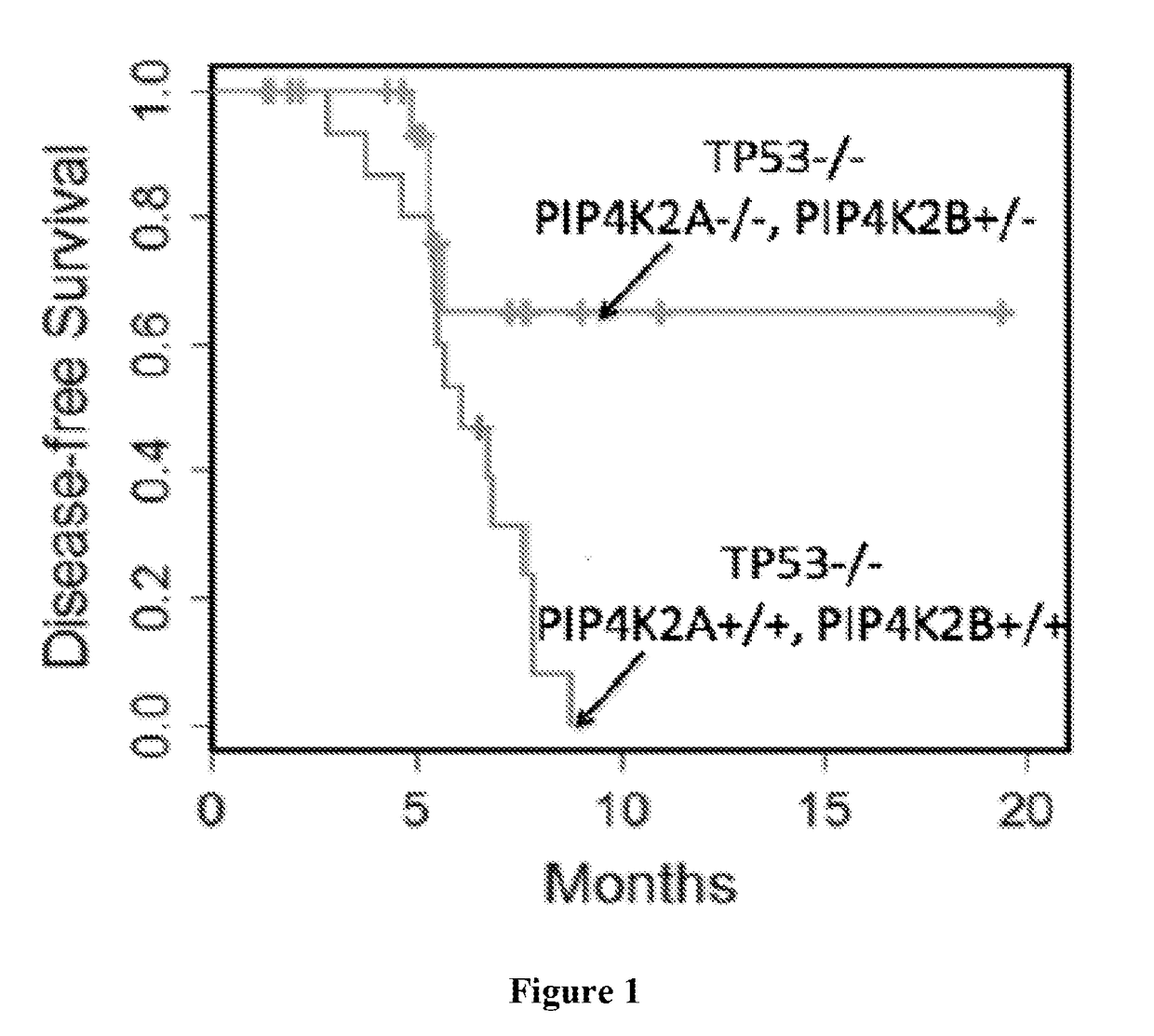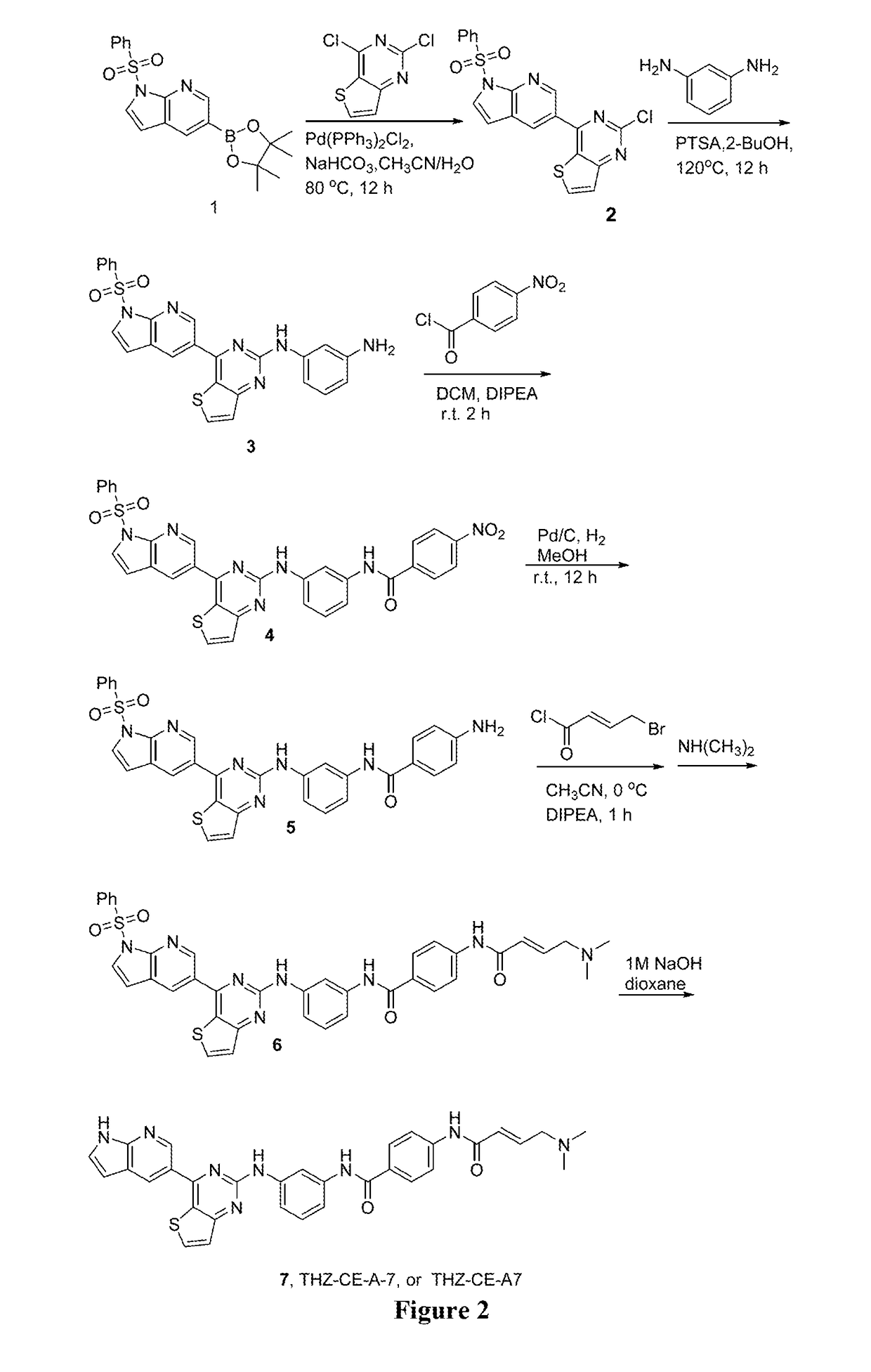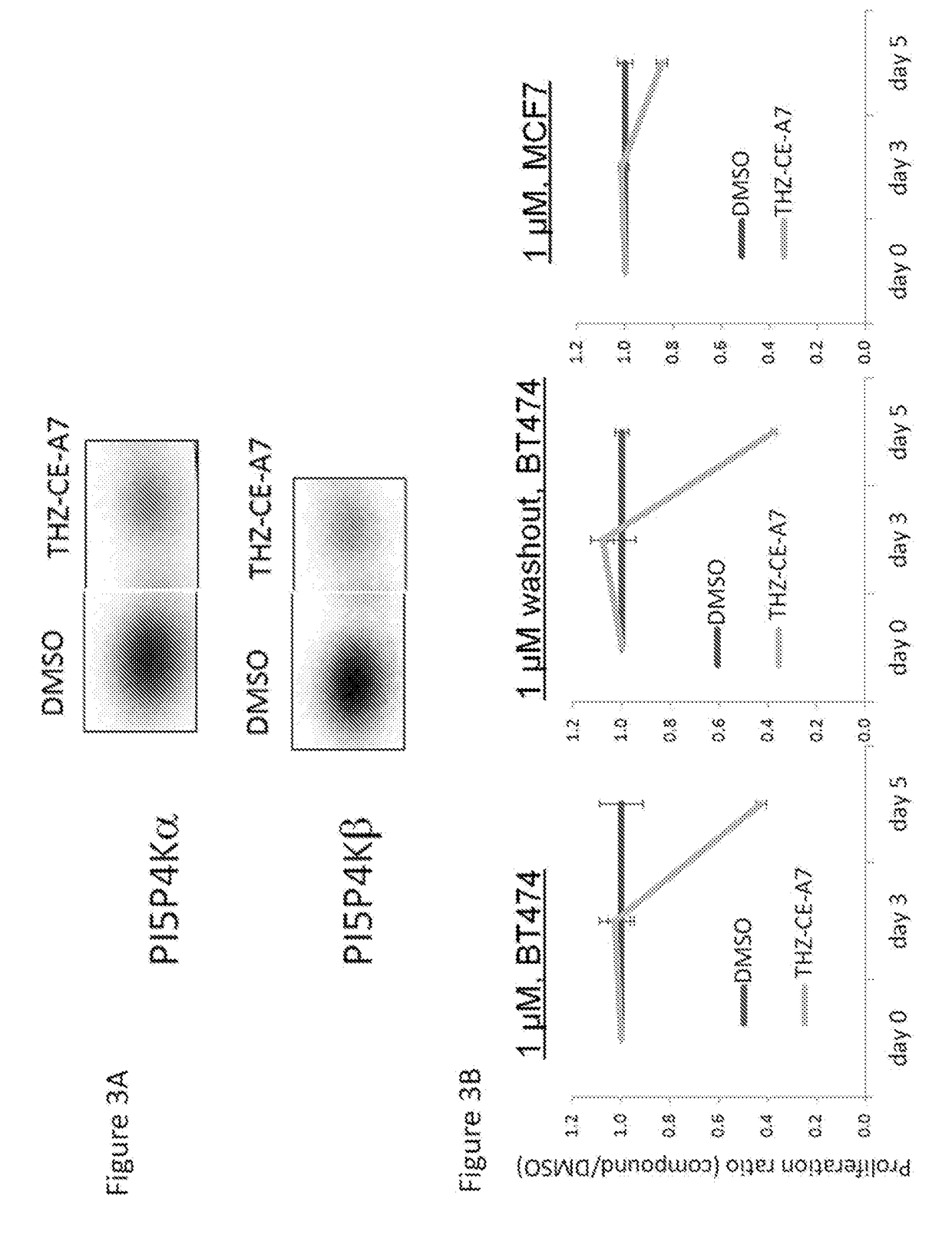Fused bicyclic pyrimidine derivatives and uses thereof
a technology of pyrimidine and derivatives, applied in the field of pyrimidine derivatives of fused bicyclic compounds, can solve the problems of limited drugs that can exploit the loss of pyrimidine, and achieve the effect of reducing, slowing, stopping or preventing the activity of a particular biological process
- Summary
- Abstract
- Description
- Claims
- Application Information
AI Technical Summary
Benefits of technology
Problems solved by technology
Method used
Image
Examples
example 2
of Compound MFH-2-25-1
[0363]
5-nitro-1-(phenylsulfonyl)-1H-pyrrolo[2,3-b]pyridine (MFH-2-6-1)
[0364]A mixture of 5-nitro-1H-pyrrolo[2,3-b]pyridine (300 mg, 1.84 mmol) and benzenesulfonyl chloride (812 mg, 4.6 mmol) in pyridine (3 mL) was refluxed for 6 hours. Then the reaction mixture was concentrated under reduced pressure, and the residue was purified by silica gel (PE / EA=0-50%) to obtain MFH-2-6-1 (530 mg, yield 95%). LCMS (m / z): 304 [M+H]+.
1-(phenylsulfonyl)-1H-pyrrolo[2,3-b]pyridin-5-amine (MFH-2-7-1)
[0365]A mixture of MFH-2-6-1 (530 mg, 1.75 mmol) and 10% Pd / C (50 mg) in MeOH (20 mL) was stirred overnight at room temperature with an H2 balloon. The mixture was filtered through CELITE, and solvent was removed to give MFH-2-7-1 (230 mg, yield 48%). LCMS (m / z): 274 [M+H]+.
2-chloro-N-(1-(phenylsulfonyl)-1H-pyrrolo[2,3-b]pyridin-5-yl)thieno[3,2-d]pyrimidin-4-amine (MFH-2-8-1)
[0366]A solution of MFH-2-7-1 (230 mg, 0.84 mmol), 2,4-dichlorothieno[3,2-d]pyrimidine (173 mg, 0.84 mmol) and...
example 3
of Compound MFH-2-40-1
[0373]
4-(1-(2-chlorothieno[3,2-d]pyrimidin-4-yl)piperidin-4-yl)morpholine (MFH-2-29-1)
[0374]To a solution of 2,4-dichlorothieno[3,2-d]pyrimidine (300 mg, 1.46 mmol) and DIPEA (227 mg, 1.76 mmol) in DCM (5 mL) was added 4-(piperidin-4-yl)morpholine (274 mg, 1.61 mmol) in DCM (3 mL) dropwise at room temperature. The mixture was stirred at room temperature for 3 hours and then was concentrated under reduced pressure. The residue was purified by silica gel (NH3 / MeOH(1.75N) / DCM=0-20%) to obtain MFH-2-29-1 (496 mg, yield 100%). LCMS (m / z): 339 [M+H]+.
tert-butyl3-(4-(4-morpholinopiperidin-1-yl)thieno[3,2-d]pyrimidin-2-ylamino)phenylcarbamate (MFH-2-32-1)
[0375]A solution of MFH-2-29-1 (496 mg, 1.46 mmol), tert-butyl 3-aminophenylcarbamate (335 mg, 1.61 mmol), 2-Dicyclohexylphosphino-2′,4′,6′-triisopropylbiphenyl (105 mg, 0.22 mmol), K2CO3 (243 mg, 1.76 mmol), and Pd2(dba)3 (201 mg, 0.22 mmol) in tert-Butanol (10 mL) was refluxed for 5 hours under N2 atmosphere. The mix...
example 4
of Compound MFH-2-44-1
[0380]
5-methoxy-1-(phenylsulfonyl)-1H-pyrrolo[2,3-b]pyridine (MFH-2-10-1)
[0381]A mixture of 5-methoxy-1H-pyrrolo[2,3-b]pyridine (800 mg, 5.4 mmol) and benzenesulfonyl chloride (1.9 g, 10.8 mmol) in pyridine (8 mL) was refluxed overnight. Then the reaction mixture was concentrated under reduced pressure, and the residue was purified by silica gel (PE / EA=0-50%) to obtain MFH-2-10-1 (646 mg, yield 42%). LCMS (m / z): 289 [M+H]+.
1-(phenylsulfonyl)-1H-pyrrolo[2,3-b]pyridin-5-ol (MFH-2-13-1)
[0382]To a solution of MFH-2-10-1 (646 mg, 2.25 mmol) in DCM (20 mL) was added boron trichloride in hexane (1 mol / L, 22.5 ml, 22.5 mmol) dropwise at −15° C. The mixture was warmed to room temperature and the mixture was stirred overnight. After completion, water (50 ml) was added at 0° C. and the aqueous layer was extracted with DCM. The combined organic layers was washed with brine, dried over Na2SO4, filtered, and concentrated. The residue was purified by silica gel column chromat...
PUM
| Property | Measurement | Unit |
|---|---|---|
| w/w | aaaaa | aaaaa |
| diameter | aaaaa | aaaaa |
| diameter | aaaaa | aaaaa |
Abstract
Description
Claims
Application Information
 Login to View More
Login to View More - R&D
- Intellectual Property
- Life Sciences
- Materials
- Tech Scout
- Unparalleled Data Quality
- Higher Quality Content
- 60% Fewer Hallucinations
Browse by: Latest US Patents, China's latest patents, Technical Efficacy Thesaurus, Application Domain, Technology Topic, Popular Technical Reports.
© 2025 PatSnap. All rights reserved.Legal|Privacy policy|Modern Slavery Act Transparency Statement|Sitemap|About US| Contact US: help@patsnap.com



